Ijraset Journal For Research in Applied Science and Engineering Technology
- Home / Ijraset
- On This Page
- Abstract
- Introduction
- Conclusion
- References
- Copyright
Finite Element Modelling and Link Element Analysis for Load Behaviour in Elastomeric Bearings: An Approach to Satisfy Design Check
Authors: Shubham Sharma, Dr. Raghvendra Singh
DOI Link: https://doi.org/10.22214/ijraset.2024.65377
Certificate: View Certificate
Abstract
The focus of this study is on the finite element modelling (FEM) and link element analysis of elastomeric bearings to evaluate load behaviour and ensure compliance with design standards. A detailed FEM was developed, incorporating material properties and boundary conditions to simulate the load transfer mechanisms that were provided through link element analysis. The results were validated against design codes and input data from analysis software data, confirming the model’s accuracy. A reliable method for optimizing elastomeric bearing design, improving structural safety, and satisfying critical design checks has presented. Total 10 Models taken with its variations and design checks applied over the same with the conclusion of whether it would be suitable or not aiming to improve design practices and address the challenges of modern bridge engineering.
Introduction
I. INTRODUCTION
Bridge engineering is recognized as a crucial field in infrastructure development, ensuring the safe and efficient movement of people and goods across natural and man-made obstacles. Bridges are subjected to various dynamic loads, including vehicular traffic, wind forces, thermal expansion, and seismic activity. To manage these forces and maintain structural integrity, the use of specialized components, such as bearings, is required. Bearings are employed to allow controlled movement between the bridge superstructure and substructure, while the distribution of loads is managed, minimizing stress on critical elements.
Elastomeric bearings, which are widely used, are designed to handle vertical loads while permitting horizontal movement and rotation. These bearings are composed of alternating layers of rubber (elastomer) and steel shims, allowing vibrations to be absorbed, effects of temperature changes to be mitigated, and deflections due to seismic and wind forces to be accommodated. Their flexible nature provides a cost-effective and low-maintenance solution for various bridge types, including highway and railway bridges.
II. APPLICATION OF ELASTOMERIC BEARING
The application of elastomeric bearings in bridge engineering ensures that smoother load distribution is achieved, the lifespan of the structure is prolonged, and the overall safety and durability of the bridge are enhanced. However, careful consideration of material properties, load conditions, and deformation behaviour has required in their design, making finite element modeling (FEM) an essential tool for analysing and optimizing their performance. By predicting how elastomeric bearings respond to various load scenarios, critical design checks can be satisfied, contributing to the long-term reliability of bridges.
In the figure below, the bridge firstly was supported only on the girder merged to the pier. Then the Elastomeric bearing applied to ROB after re-refection of actual shear forces, bending moment and torsional moment
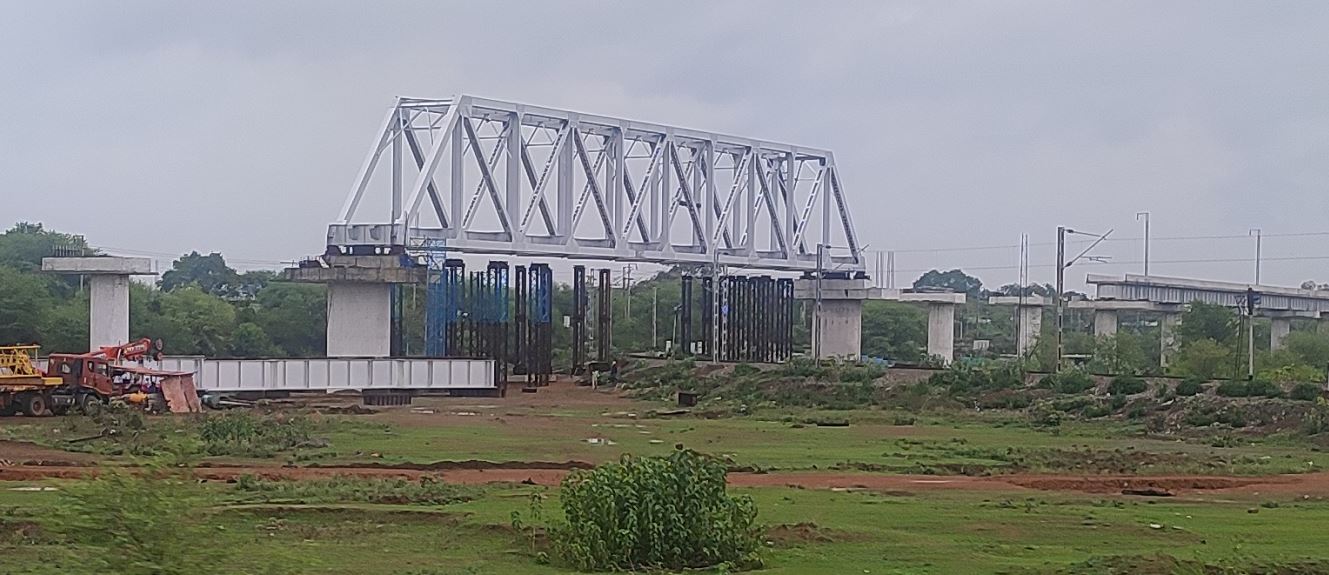 Fig. 1: Elastomeric bearing used in ROB
Fig. 1: Elastomeric bearing used in ROB
III. RESEARCH OBJECTIVES
On keeping in mind the above problem statement outlined for new research work for elastomeric bearing are given below :-
- To check behavior in the analysis, it is recommended to take different Model cases considering the thickness of each layer of bearing as constant throughout all model cases and changing only bearing pad dimensions as variable.
- For accuracy in analysis, it has recommended to make the variants of each of the model cases
- To simulate precisely, it has recommended to use the FEM analysis over each variants.
- Loading used over the bridge should be highest as per IRC 6:2017.
- For the stability in the simulation, it has suggested that to conduct different design checks for the values obtained as per the output parameters decided.
- At last, in the research, the most stable cases list after passing the design tests can be taken into account that provides the recommendations that will made a feasible construction reference.
IV. 3D MODELLING OF THE STRUCTURE
Comprehensive input data and its descriptions about the model given below. The input data used for creation of elastomeric bearing using link element using general data and loading data have shown below:-
Table 1: Loading data used for all model cases
|
Constraint |
Data used for all cases |
|
IRC loading |
70R |
|
Vehicle width |
2.79 m |
|
Dead load |
Self-Weight |
Table 2: General input data used for all model cases
|
Constraint |
Data used for all cases |
|
Deck Span length |
12m |
|
Deck width |
5m |
|
Deck Span thickness |
300mm |
|
Transverse girder properties |
500 mm x 300 mm |
|
Number of plate meshing |
10 x 10 |
|
Longitudinal girder properties |
Beam selected = tapered I section |
|
Property used = Steel section |
|
|
|
|
|
Concrete & Rebar grade |
M30 & FE 500 |
|
Shear Modulus (G) |
0.9 N/sq. mm (IRC 83, Table 1) |
|
Modulus of Elasticity of Elastomer (E) |
617263 KG/sq. m (from Ref. paper 1) |
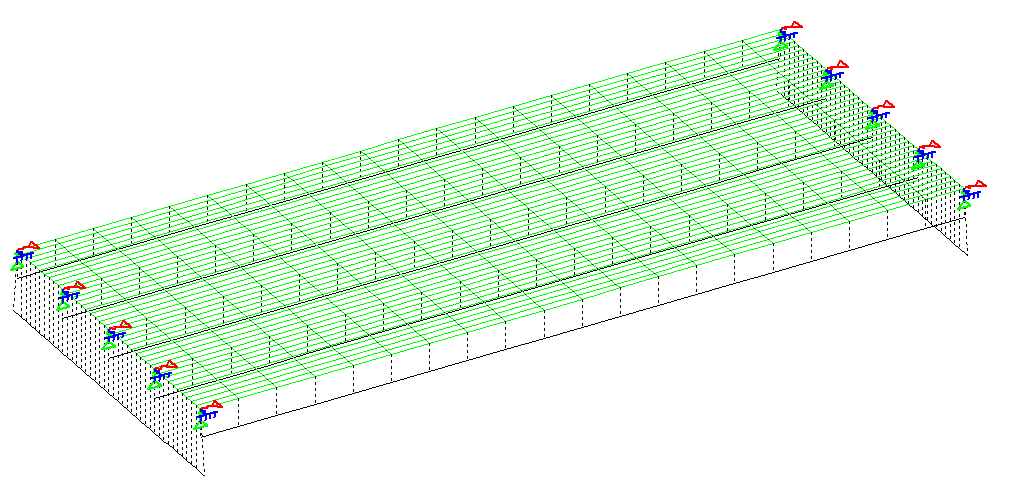 Fig. 2: Plan view of bridge
Fig. 2: Plan view of bridge
Table 3: Various model cases used for analysis with subsequent variant and its configuration
|
Models framed for analysis |
Abbreviation |
Subsequent variant |
Variant Configuration |
|
Bridge deck supported over laminated elastomeric bearing with effective area of 160mm x 250mm |
Model 1 |
EB1A |
1E, 2O, 2S |
|
EB1B |
2E, 2O, 3S |
||
|
EB1C |
3E, 2O, 4S |
||
|
EB1D |
4E, 2O, 5S |
||
|
Bridge deck supported over laminated elastomeric bearing with effective area of 160mm x 320mm |
Model 2 |
EB2A |
1E, 2O, 2S |
|
EB2B |
2E, 2O, 3S |
||
|
EB2C |
3E, 2O, 4S |
||
|
EB2D |
4E, 2O, 5S |
||
|
Bridge deck supported over laminated elastomeric bearing with effective area of 200mm x 320mm |
Model 3 |
EB3A |
1E, 2O, 2S |
|
EB3B |
2E, 2O, 3S |
||
|
EB3C |
3E, 2O, 4S |
||
|
EB3D |
4E, 2O, 5S |
||
|
Bridge deck supported over laminated elastomeric bearing with effective area of 200mm x 400mm |
Model 4 |
EB4A |
1E, 2O, 2S |
|
EB4B |
2E, 2O, 3S |
||
|
EB4C |
3E, 2O, 4S |
||
|
EB4D |
4E, 2O, 5S |
||
|
Bridge deck supported over laminated elastomeric bearing with effective area of 250mm x 400mm |
Model 5 |
EB5A |
1E, 2O, 2S |
|
EB5B |
2E, 2O, 3S |
||
|
EB5C |
3E, 2O, 4S |
||
|
EB5D |
4E, 2O, 5S |
||
|
Bridge deck supported over laminated elastomeric bearing with effective area of 250mm x 500mm |
Model 6 |
EB6A |
1E, 2O, 2S |
|
EB6B |
2E, 2O, 3S |
||
|
EB6C |
3E, 2O, 4S |
||
|
EB6D |
4E, 2O, 5S |
||
|
Bridge deck supported over laminated elastomeric bearing with effective area of 320mm x 500mm |
Model 7 |
EB7A |
1E, 2O, 2S |
|
EB7B |
2E, 2O, 3S |
||
|
EB7C |
3E, 2O, 4S |
||
|
EB7D |
4E, 2O, 5S |
||
|
EB7E |
5E, 2O, 6S |
||
|
Bridge deck supported over laminated elastomeric bearing with effective area of 320mm x 630mm |
Model 8 |
EB8A |
1E, 2O, 2S |
|
EB8B |
2E, 2O, 3S |
||
|
EB8C |
3E, 2O, 4S |
||
|
EB8D |
4E, 2O, 5S |
||
|
EB8E |
5E, 2O, 6S |
||
|
Bridge deck supported over laminated elastomeric bearing with effective area of 320mm x 630mm |
Model 9 |
EB9A |
1E, 2O, 2S |
|
EB9B |
2E, 2O, 3S |
||
|
EB9C |
3E, 2O, 4S |
||
|
EB9D |
4E, 2O, 5S |
||
|
EB9E |
5E, 2O, 6S |
||
|
Bridge deck supported over laminated elastomeric bearing with effective area of 400mm x 800mm |
Model 10 |
EB10A |
1E, 2O, 2S |
|
EB10B |
2E, 2O, 3S |
||
|
EB10C |
3E, 2O, 4S |
||
|
EB10D |
4E, 2O, 5S |
||
|
EB10E |
5E, 2O, 6S |
||
|
EB10F |
6E, 2O, 7S |
|
Here, EB = Elastomeric Bearing, |
|
|
9A = Variant A for model number 9 |
2O = 2 Outer Elastomeric layer |
|
1E = 1 Elastomeric sheet layer |
2S = 2 Steel laminate layer |
V. DESIGN CHECK PROCEDURE OF BEARING AS PER IRC 83
The procedure followed to observe whether the bearing created by link element has safe to resist from failure mentioned below:-
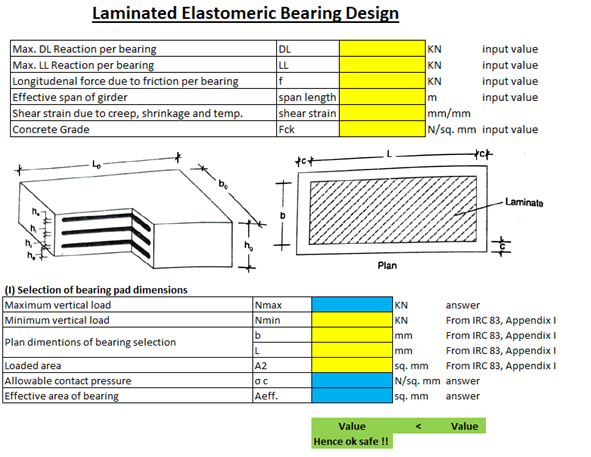
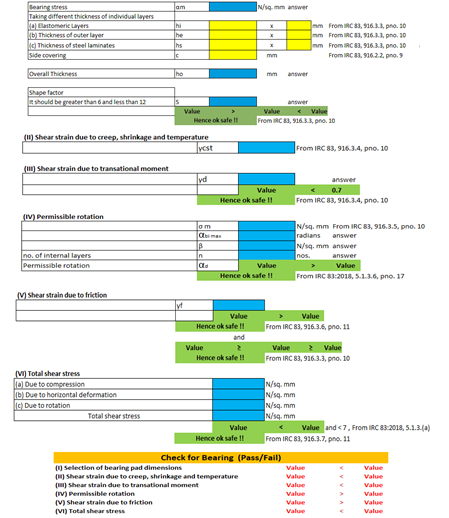
Fig. 3: Sample of different checks conducted for model
VI. RESULTS AND DISCUSSION
Though our result analysis consists Total 10 distinct model cases and each having different variants of elastomeric bearing cases. The result analysis approach allowed us to observe a range of outcomes for each case within the structure since different variants shows different behaviour under 70R loading. As a result of this comparative analysis, we obtained subsequent findings for the mentioned cases provided below:-
Table 4: Result analysis for various models with notes
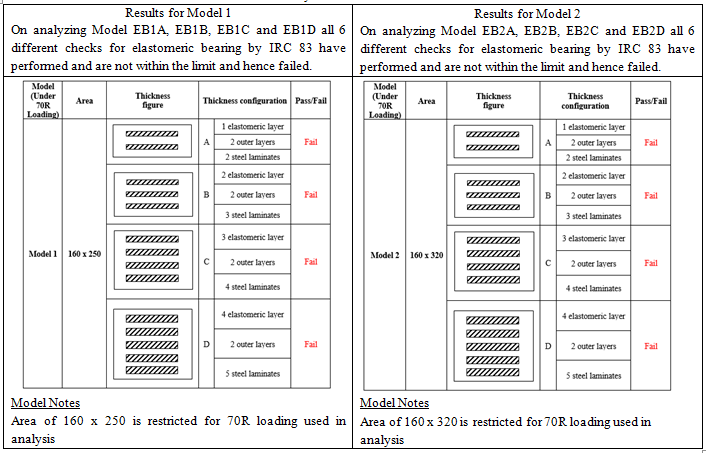
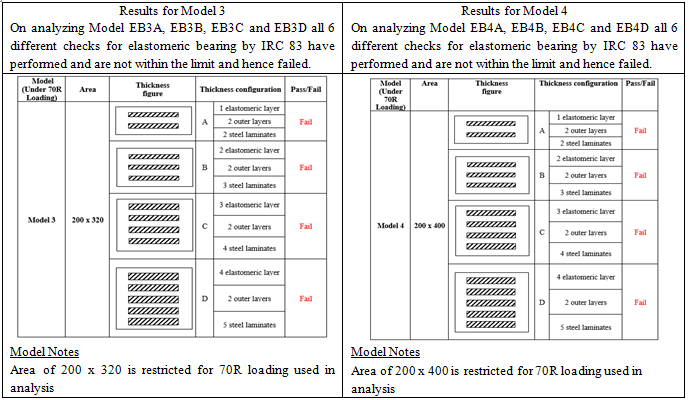


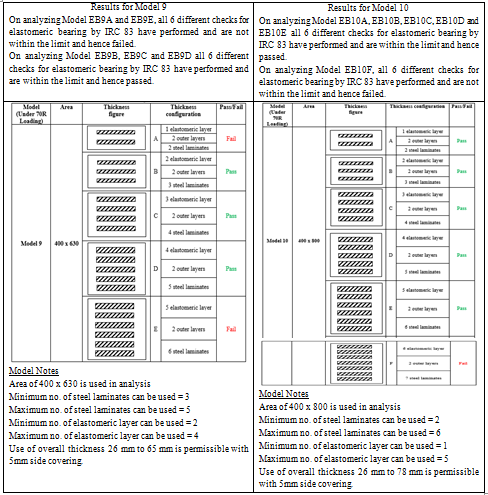
Conclusion
This project concluded that the simulation for 70R loading on different elastomeric pad dimensions, comparing each model having each variants, some model variants are failed but some are passed. Details of recommended variants are mentioned below:-
References
[1] Can Akogul et.al. (2008), “Effect Of Elastomeric Bearing Modeling Parameters On The Seismic Design Of RC Highway Bridges With Precast Concrete Girders”, The 14th World Conference on Earthquake Engineering October 12-17, 2008, Beijing, China. [2] Santoso, A. K. et. al. (2022). Structural Systems Comparison of Simply Supported PSC Box Girder Bridge Equipped with Elastomeric Rubber Bearing and Lead Rubber Bearing. Civil Engineering Dimension, 24(1), 19–30. [3] Aghelfard, A. et. al. (2019). Investigating The Performance Of Bridges Equipped With Elastomeric Bearings Reinforced With Fibre Under Traffic And Seismic Loads. Scientific Journal of Silesian University of Technology Series Transport, 104, 5–14. [4] Rubaee, S. K. A. et. al. (2019). Seismic Behavior of Composite Simply Supported Bridge Decks supported on Elastomeric Bearings. IOP Conference Series Materials Science and Engineering, 584(1), 012058. [5] Mustafa, S. et. al. (2020). Design of Rupture Strength of Side Blocks in Elevated Steel Girder Bridges with Elastomeric Bearings. International Journal of Steel Structures, 20(3), 885–896. [6] Erduran, E. et. al. (2022). Effect of Elastomeric Bearing Stiffness on the Dynamic Response of Railway Bridges Considering Vehicle–Bridge Interaction. Applied Sciences, 12(23), 11952. [7] Vasu Shekhar Tanwar, Sagar Jamle, (2018), \"Analysis of Box Culvert to Reduce Stress Values\". International Journal of Advanced Engineering Research and Science (ISSN: 2349-6495(P) | 2456-1908(O)), vol. 5, no. 5, pp.103-105 AI Publications, doi:10.22161/ijaers.5.5.14. [8] Sarita?, F. (2022). Effect of Elastomeric Bearings in Bridge Piers. DÜMF Mühendislik Dergisi. [9] Braga, G., et. al. (2020). Analysis of Neoprene Bearings on Requests and Strains. In International Journal of Applied Engineering Research (pp. 40–47) [Journal-article]. Research India Publications. [10] Bakhtiari, P., & Bargi, K. (2020). Seismic Vulnerability Assessment of High-Speed Railway Bridges Using Fragility Curves and Considering Soil-Structure Interaction. Civil and Environmental Engineering, 16(1), 39–48. [11] Xiang, N. et. al. (2021). Effect of bonding or unbonding on seismic behavior of bridge elastomeric bearings: lessons learned from past earthquakes in China and Japan and inspirations for future design. Advances in Bridge Engineering, 2(1). [12] Fediuc, D. O. et. al. (2015). Finite Element Modelling Of Elastomeric Bearings. Bulletin of the Polytechnic Institute of Jassy, CONSTRUCTIONS. ARCHITECTURE Section, 20–22. [13] Casarotti, C., et. al. (2008). STUDY OF A PHENOMENOLOGICAL MODEL FOR ELASTOMERIC BEARINGS [Conference-proceeding]. [14] Roshan Patel, Sagar Jamle, (2019), “Analysis and Design of Box Culvert: A Manual Approach”, International Journal of Advanced Engineering Research and Science(ISSN : 2349-6495(P) | 2456-1908(O)),vol. 6, no. 3, pp. 286-291, AI Publications, doi:10.22161/ijaers.6.3.3.7. [15] Vasu Shekhar Tanwar, Dr. M. P. Verma, Sagar Jamle, (2018), “Analytic Study of Box Culvert to Reduce Bending Moment and Displacement Values”, International Journal of Current Engineering and Technology, IJCET, Vol. 8, no. 3, pp. 762-764, DOI: https://doi.org/10.14741/ijcet/v.8.3.33 [16] Febymol, K., & Nair, R. (2017). Finite Element Analysis of Elastomeric Bearing. International Research Journal of Advanced Engineering and Science, 2, 175–178. [17] Deshmukh, N. V., & Waghe, Dr. U. P. (2015). Analysis and Design of Skew Bridges. International Journal of Science and Research (IJSR), 4(4).
Copyright
Copyright © 2024 Shubham Sharma, Dr. Raghvendra Singh. This is an open access article distributed under the Creative Commons Attribution License, which permits unrestricted use, distribution, and reproduction in any medium, provided the original work is properly cited.

Download Paper
Paper Id : IJRASET65377
Publish Date : 2024-11-19
ISSN : 2321-9653
Publisher Name : IJRASET
DOI Link : Click Here
 Submit Paper Online
Submit Paper Online

